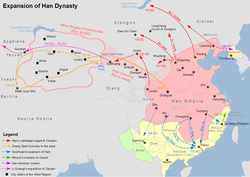Han Chinese
Han Chinese (also called Han; simplified Chinese: 汉族; traditional Chinese: 漢族; pinyin: Hàn zú) is an ethnic group within East Asian people. 92% of the Chinese population and more than 97% of the Taiwanese population are Han. Out of the entire human population in the world, 19% are Han Chinese. Han Chinese have the highest concentrations in the Eastern Provinces of China, particularly in the Hebei, Jiangsu and Guangdong regions. There are tens of millions of overseas Han Chinese. The majority live in Southeast Asia. Many big cities around the world have enough "overseas Chinese" to make a "Chinatown".
| Total population | |
|---|---|
| 1,300,000,000 worldwide | |
| Regions with significant populations | |
| Areas of high populations | |
| 1,207,541,842[1] | |
| - | 6,593,410[2] |
| - | 433,641[3] |
| 22,575,365[4] | |
| 2,684,936[5] | |
| 7,053,240[6] | |
| 6,590,500 | |
| [7] | |
| 3,376,031[8] | |
| 2,832,510[9] | |
| 1,612,173[10] | |
| 1,300,000[11] | |
| 1,263,570[12] | |
| 1,146,250[13] | |
| 1,101,314[14] | |
| 998,000[15] | |
| 620,000[16] | |
| 519,561[17] | |
| 343,855[18] | |
| 296,623[19] | |
| 230,515[20] | |
| 189,470[21] | |
| 185,765[22] | |
| Languages | |
| Chinese | |
| Religion | |
| Mahayana Buddhism, Confucianism, Taoism, Chinese folk religion and Irreligion, Christianity | |
The name
The name "Han" comes from the Han Dynasty that united China as one country. During the Han Dynasty, many tribes felt that they belonged to the same ethnic group. Also, the Han Dynasty is said to be the high point in Chinese civilization. During the Han Dynasty, China was able to increase its power and influence to other parts of Asia.
There are some slang words and different names for Han amongst some Han people, especially in southern China and in Vietnam. In languages like Cantonese, Hakka and Min Nan, the word "Táng Rén" is also used. "Táng Rén" is written as "唐人" and it literally means "the people of Tang." It is pronounced "Tong Yan" in Cantonese. "唐人" comes from another Chinese dynasty, the Tang Dynasty. The Tang Dynasty is also another peak point of the Chinese civilization. Within English-speaking Han communities, the word "Chinatown" in Chinese is "Táng Rén Jiē" which means "street of the Tang people."
Another phrase used by the Han people, especially overseas Chinese, is "Hua Ren" (simplified Chinese: 华人; traditional Chinese: 華人; pinyin: huá rén). It comes from "Zhong Hua" (simplified Chinese: 中华; traditional Chinese: 中華; pinyin: zhōng huá), a poetic name for China. The translation of this is "ethnic Chinese".
Culture
Han China is one of the world's oldest civilizations. Chinese culture dates back thousands of years. Some Han people believe they share common ancestors, distantly related to the Yellow Emperor and Yan Emperor, who existed thousands of years ago. Hence, some people of Han call themselves "Descendants of the Yan Emperor" or "Descendants of the Yellow Emperor."
Throughout the history of China, Chinese culture has been influenced by Confucianism, Taoism and Buddhism. Confucianism was the official philosophy throughout most of Imperial China's history, and becoming a professional of Confucian texts was needed to be part of the imperial bureaucracy.
Han Chinese Media
The percentage of Han Chinese by county level, including Mainland China, Taiwan, Hong Kong, and Macau
A map showing the southward expansion of the Han dynasty during the 2nd century BC
The major nomadic groups involved in the Uprising of the Five Barbarians
Guo Ziyi, who quelled the An Lushan rebellion, which caused a fall in recorded numbers of Tang inhabitants from 53 million to 17 million people
Yue Fei, who was a general of the Song dynasty against the Jurchen (Jin) invasion, is considered a Chinese national hero and is often worshipped alongside Guan Yu in martial temples.
References
Related pages
Other websites
- Defining Han Identity in Chinese Ethnology and Archaeology Research website on Han identity by Ph.D. candidate
- How the Han Chinese became the world's biggest tribe Archived 2005-05-16 at the Wayback Machine – Yahoo News/AFP Sept 15, 2004










